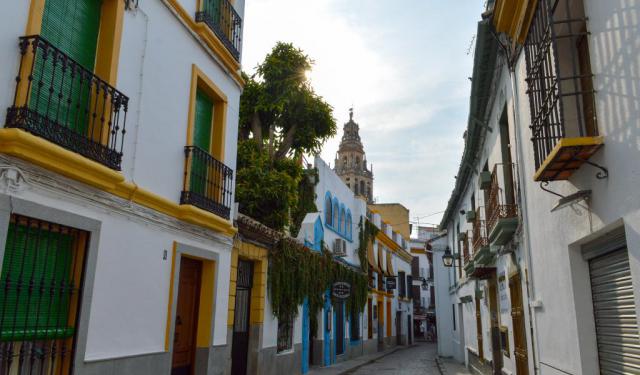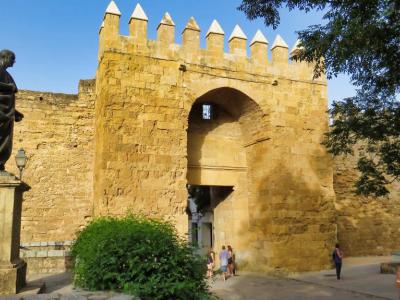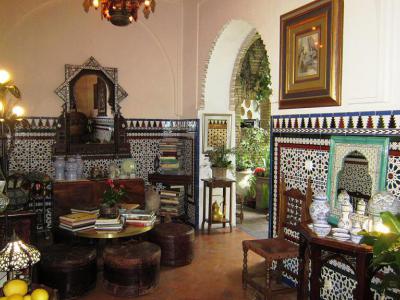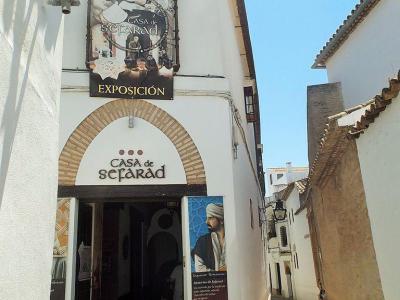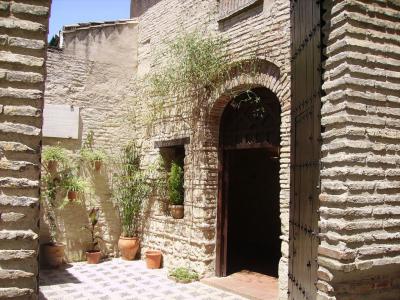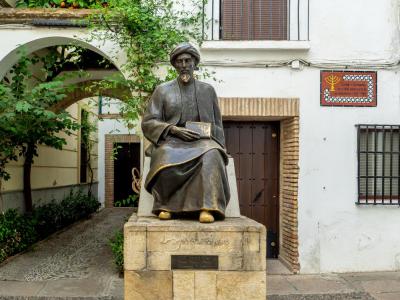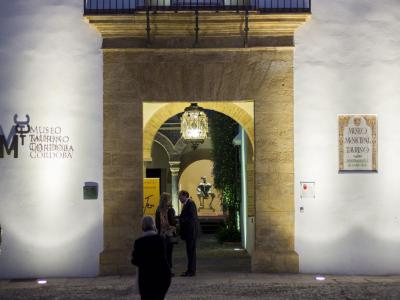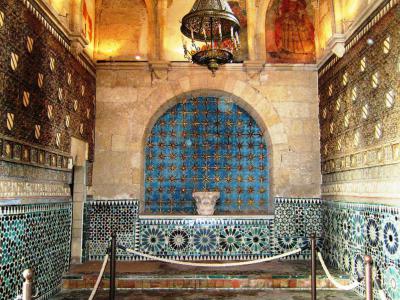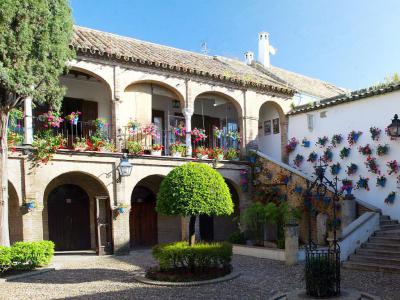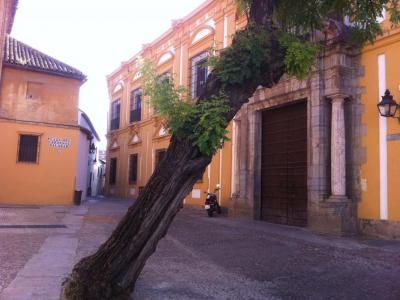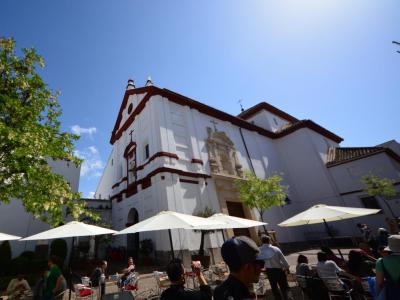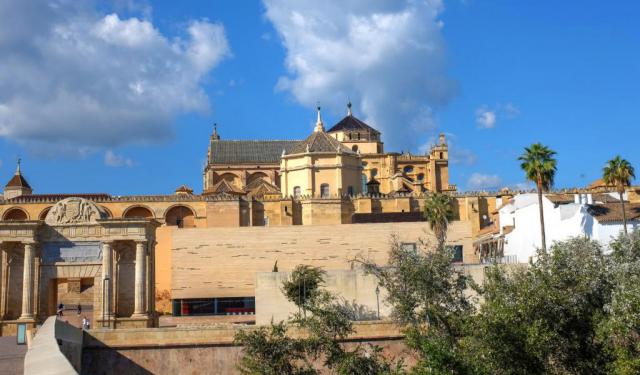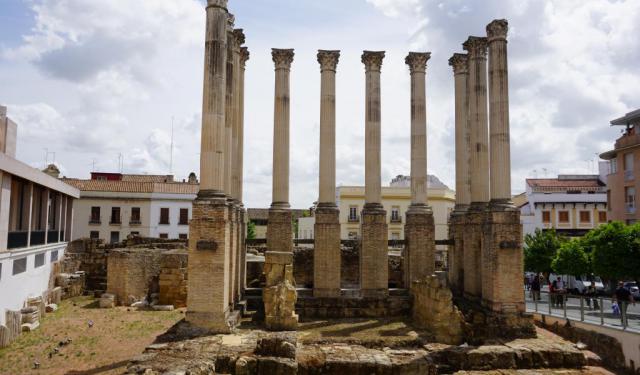Audio Guide: Cordoba Jewish Quarter Walk (Self Guided), Cordoba
Córdoba’s Jewish Quarter is one of the most atmospheric and historically rich districts of the city, located within the UNESCO-listed historic center. Its origins trace back to the Roman period, but it flourished most prominently during the Middle Ages, when Córdoba stood as one of the most important intellectual and cultural centers in Europe.
Under Muslim rule from the 8th to the 13th century, Jewish communities in Córdoba enjoyed a period often described as a Golden Age of Jewish life. Jews played major roles in science, philosophy, literature, and political life. The most celebrated figure from this community is Moses Maimonides, a philosopher and theologian whose works — including The 13 Principles of Faith and a monumental legal code — continue to shape Jewish thought across the world.
The Jewish Quarter developed into a vibrant enclave, characterized by narrow, winding streets, whitewashed houses, and intimate courtyards designed for shade and privacy — responses to the hot Andalusian climate. Jewish life centered around synagogues, markets, artisan workshops, and educational centers, forming a dynamic and thriving neighborhood within the city.
However, this period of prosperity came to an abrupt end in 1236, when Christian forces under King Ferdinand III conquered Córdoba. Although the Jewish community continued to exist for over two centuries under Christian rule, growing restrictions and rising religious tensions increasingly limited Jewish freedoms. The turning point came in 1492, when the Catholic Monarchs, Isabella I and Ferdinand II, issued the Alhambra Decree, expelling Jews from Spain who refused religious conversion. Many left Spain; others converted while secretly preserving their heritage behind closed doors.
Despite the Jewish Quarter's decline after 1492, some elements of its Jewish heritage survived, particularly through the preservation of certain landmarks. The Synagogue of Córdoba, for example, is one of the best-preserved examples of medieval Jewish architecture in Spain.
A walk through Córdoba’s Jewish Quarter today offers visitors a journey through a maze of whitewashed alleys, bright courtyards draped in flowers, and charming artisanal shops. Highlights include the 14th-century Synagogue, the Casa de Sefarad museum, and the statue of Maimonides. These landmarks provide a glimpse into the neighborhood’s rich history and enduring cultural legacy, making it a must-visit destination for anyone interested in exploring the deep, multifaceted history of Córdoba.
Under Muslim rule from the 8th to the 13th century, Jewish communities in Córdoba enjoyed a period often described as a Golden Age of Jewish life. Jews played major roles in science, philosophy, literature, and political life. The most celebrated figure from this community is Moses Maimonides, a philosopher and theologian whose works — including The 13 Principles of Faith and a monumental legal code — continue to shape Jewish thought across the world.
The Jewish Quarter developed into a vibrant enclave, characterized by narrow, winding streets, whitewashed houses, and intimate courtyards designed for shade and privacy — responses to the hot Andalusian climate. Jewish life centered around synagogues, markets, artisan workshops, and educational centers, forming a dynamic and thriving neighborhood within the city.
However, this period of prosperity came to an abrupt end in 1236, when Christian forces under King Ferdinand III conquered Córdoba. Although the Jewish community continued to exist for over two centuries under Christian rule, growing restrictions and rising religious tensions increasingly limited Jewish freedoms. The turning point came in 1492, when the Catholic Monarchs, Isabella I and Ferdinand II, issued the Alhambra Decree, expelling Jews from Spain who refused religious conversion. Many left Spain; others converted while secretly preserving their heritage behind closed doors.
Despite the Jewish Quarter's decline after 1492, some elements of its Jewish heritage survived, particularly through the preservation of certain landmarks. The Synagogue of Córdoba, for example, is one of the best-preserved examples of medieval Jewish architecture in Spain.
A walk through Córdoba’s Jewish Quarter today offers visitors a journey through a maze of whitewashed alleys, bright courtyards draped in flowers, and charming artisanal shops. Highlights include the 14th-century Synagogue, the Casa de Sefarad museum, and the statue of Maimonides. These landmarks provide a glimpse into the neighborhood’s rich history and enduring cultural legacy, making it a must-visit destination for anyone interested in exploring the deep, multifaceted history of Córdoba.
How it works: Download the app "GPSmyCity: Walks in 1K+ Cities" from Apple App Store or Google Play Store to your mobile phone or tablet. The app turns your mobile device into a personal tour guide and its built-in GPS navigation functions guide you from one tour stop to next. The app works offline, so no data plan is needed when traveling abroad.
Cordoba Jewish Quarter Walk Map
Guide Name: Cordoba Jewish Quarter Walk
Guide Location: Spain » Cordoba (See other walking tours in Cordoba)
Guide Type: Self-guided Walking Tour (Sightseeing)
# of Attractions: 10
Tour Duration: 1 Hour(s)
Travel Distance: 0.4 Km or 0.2 Miles
Author: DanaOffice
Sight(s) Featured in This Guide:
Guide Location: Spain » Cordoba (See other walking tours in Cordoba)
Guide Type: Self-guided Walking Tour (Sightseeing)
# of Attractions: 10
Tour Duration: 1 Hour(s)
Travel Distance: 0.4 Km or 0.2 Miles
Author: DanaOffice
Sight(s) Featured in This Guide:
- Puerta de Almodovar (Almodovar Gate)
- Casa Andalusi (Andalusian House Museum)
- Casa de Sefarad (House of Sefarad)
- Sinagoga de Cordoba (Cordoba Synagogue)
- Maimónides Square and Statue
- Museo Taurino (Bullfighting Museum)
- Capilla Mudejar de San Bartolome (Chapel of St. Bartholomew)
- El Zoco Municipal Souk
- Plaza del Cardenal Salazar (Cardenal Salazar Square)
- Iglesia de San Pedro de Alcantara (Church of St. Peter of Alcantara)
1) Puerta de Almodovar (Almodovar Gate)
The Almodóvar Gate isn’t just a hole in Córdoba’s old town walls-it’s a survivor. Dating from the 14th century, it’s one of only three medieval gates still standing, named for the road that once led to the nearby town of Almodóvar del Río. Built from sandstone and brick, the gate’s big open arch is flanked by two sturdy towers capped with battlements, like it’s still half-expecting trouble from the past. Step through and you’re straight into the Jewish Quarter, where the streets seem to have been designed by someone who liked puzzles.
Just outside, Cairuán Street runs alongside the walls like a quiet backstage corridor. It’s a stone walkway shaded by greenery, with a fountain feeding a neat row of rectangular ponds-an easy stroll for anyone wanting a break from the city’s buzz.
Keeping watch by the gate is a bronze statue of Seneca the Younger, born here in 4 B.C., who went on to become a Roman philosopher, playwright, and, at times, reluctant political insider. Follow Cairuán Street a little further and you’ll meet another hometown heavyweight: Averroes, the medieval philosopher who brought Aristotle back into fashion in the Islamic world. Two thinkers, two statues, and one gate that’s been standing long enough to hear it all.
Just outside, Cairuán Street runs alongside the walls like a quiet backstage corridor. It’s a stone walkway shaded by greenery, with a fountain feeding a neat row of rectangular ponds-an easy stroll for anyone wanting a break from the city’s buzz.
Keeping watch by the gate is a bronze statue of Seneca the Younger, born here in 4 B.C., who went on to become a Roman philosopher, playwright, and, at times, reluctant political insider. Follow Cairuán Street a little further and you’ll meet another hometown heavyweight: Averroes, the medieval philosopher who brought Aristotle back into fashion in the Islamic world. Two thinkers, two statues, and one gate that’s been standing long enough to hear it all.
2) Casa Andalusi (Andalusian House Museum)
The Andalusian House feels less like a museum and more like you’ve just wandered into the 12th century and no one’s told the owners. This small Moorish gem wraps itself around a leafy courtyard, a cool refuge just steps from the synagogue and a short stroll from the Almodóvar Gate.
Inside, rooms brim with the spoils of medieval home life-plush furnishings, hand-woven tapestries, shelves of old books, and enough delicate pottery to make you walk carefully. The décor leans heavily on Moorish elegance with a dash of Eastern flair, from its geometric tilework to its arched wall recesses.
The courtyard is its own quiet theatre: patterned cobblestones underfoot, arcaded porches framing the space, and fountains murmuring under a canopy of vines and potted greenery. For a shift in mood, head below ground to find a Roman floor and other remnants dug straight out of the city’s earlier layers.
And then there’s the Paper Museum-an unexpected detour into the world of early papermaking. Here you’ll find tools, history, and even a wooden scale model of one of the West’s earliest paper mills, proof that this city’s appetite for knowledge wasn’t just about collecting books-it knew how to make them, too.
Inside, rooms brim with the spoils of medieval home life-plush furnishings, hand-woven tapestries, shelves of old books, and enough delicate pottery to make you walk carefully. The décor leans heavily on Moorish elegance with a dash of Eastern flair, from its geometric tilework to its arched wall recesses.
The courtyard is its own quiet theatre: patterned cobblestones underfoot, arcaded porches framing the space, and fountains murmuring under a canopy of vines and potted greenery. For a shift in mood, head below ground to find a Roman floor and other remnants dug straight out of the city’s earlier layers.
And then there’s the Paper Museum-an unexpected detour into the world of early papermaking. Here you’ll find tools, history, and even a wooden scale model of one of the West’s earliest paper mills, proof that this city’s appetite for knowledge wasn’t just about collecting books-it knew how to make them, too.
3) Casa de Sefarad (House of Sefarad)
The House of Sefarad in Córdoba, is a museum dedicated to preserving and showcasing the history and culture of the Sephardic Jewish community in Spain. The museum's name comes from the Hebrew word for Spain.
Located in the heart of the historic Jewish Quarter, the museum offers a glimpse into the life and legacy of Jews in medieval Spain, particularly before their expulsion in 1492. The building itself is a typical example of a traditional Andalusian home, with beautiful courtyards, intricate tiles, and detailed architectural elements that reflect the fusion of Islamic, Christian, and Jewish influences in the region.
Visitors to the House of Sefarad can explore exhibitions that cover various aspects of Sephardic culture, including religious practices, language, music, and cuisine. The museum also highlights the important contributions of Sephardic Jews to Spanish society, as well as the complex history of their expulsion and subsequent diaspora. Special focus is given to the Jewish community’s impact on Córdoba, once a major center of Jewish learning and culture during the Caliphate of Córdoba in the 10th century.
Located in the heart of the historic Jewish Quarter, the museum offers a glimpse into the life and legacy of Jews in medieval Spain, particularly before their expulsion in 1492. The building itself is a typical example of a traditional Andalusian home, with beautiful courtyards, intricate tiles, and detailed architectural elements that reflect the fusion of Islamic, Christian, and Jewish influences in the region.
Visitors to the House of Sefarad can explore exhibitions that cover various aspects of Sephardic culture, including religious practices, language, music, and cuisine. The museum also highlights the important contributions of Sephardic Jews to Spanish society, as well as the complex history of their expulsion and subsequent diaspora. Special focus is given to the Jewish community’s impact on Córdoba, once a major center of Jewish learning and culture during the Caliphate of Córdoba in the 10th century.
4) Sinagoga de Cordoba (Cordoba Synagogue)
The Córdoba Synagogue is a historic Jewish place of worship located in the heart of Córdoba’s Jewish Quarter. Built in 1315, during the reign of the Nasrid dynasty, it is one of the best-preserved examples of medieval Jewish architecture in Spain. The synagogue is a beautiful example of Mudejar style, which blends Islamic, Christian, and Jewish artistic influences, reflecting the multicultural atmosphere of Andalusia during the Middle Ages.
The synagogue is relatively small but exquisitely detailed, featuring intricately decorated stucco walls, beautiful Hebrew inscriptions, and geometric patterns that characterize the Mudejar aesthetic. The main prayer hall is the star, with its wooden ceiling, adorned with delicate carvings, and a well-preserved ark (which is the sacred storage for Torah scrolls). Visitors can explore the building and learn about its history as one of the key Jewish religious centers in medieval Córdoba before the expulsion of Jews from Spain in 1492.
After the expulsion, the synagogue was converted into a church, and it later became a museum. Today, the Córdoba Synagogue is a significant cultural and historical site, offering a glimpse into the life of the Jewish community in medieval Spain.
The synagogue is relatively small but exquisitely detailed, featuring intricately decorated stucco walls, beautiful Hebrew inscriptions, and geometric patterns that characterize the Mudejar aesthetic. The main prayer hall is the star, with its wooden ceiling, adorned with delicate carvings, and a well-preserved ark (which is the sacred storage for Torah scrolls). Visitors can explore the building and learn about its history as one of the key Jewish religious centers in medieval Córdoba before the expulsion of Jews from Spain in 1492.
After the expulsion, the synagogue was converted into a church, and it later became a museum. Today, the Córdoba Synagogue is a significant cultural and historical site, offering a glimpse into the life of the Jewish community in medieval Spain.
5) Maimónides Square and Statue
Maimónides Square, located in the heart of Córdoba’s Jewish Quarter, is dedicated to one of the city’s most influential historical figures: the philosopher, physician, and theologian Moses Maimonides. Born in Córdoba during the height of its cultural flourishing under Muslim rule, Maimonides later became one of the most important thinkers in Jewish history, shaping philosophy and law for centuries to come. His legacy makes this plaza not just a scenic corner of the neighborhood, but a symbolic tribute to the city’s intellectual Golden Age.
The centerpiece of the square is a bronze statue of Maimonides, created in 1964. The philosopher is depicted seated, holding a book — a reference to his vast scholarly output, which includes “The Guide for the Perplexed” and his influential legal writings. Many visitors gently touch the statue’s bronze foot, a charming tradition believed to bring good fortune and wisdom.
Surrounded by narrow alleyways, whitewashed façades, and artisan workshops, the square offers a peaceful moment to reflect on the deep blend of cultures that once thrived here.
The centerpiece of the square is a bronze statue of Maimonides, created in 1964. The philosopher is depicted seated, holding a book — a reference to his vast scholarly output, which includes “The Guide for the Perplexed” and his influential legal writings. Many visitors gently touch the statue’s bronze foot, a charming tradition believed to bring good fortune and wisdom.
Surrounded by narrow alleyways, whitewashed façades, and artisan workshops, the square offers a peaceful moment to reflect on the deep blend of cultures that once thrived here.
6) Museo Taurino (Bullfighting Museum)
The Bullfighting Museum sits within the Jewish Quarter, housed in a charming 16th-century Renaissance palace known as the House of the Bulls. Though Córdoba is more often associated with scholars and philosophers, the city also played a significant role in shaping Spain’s bullfighting tradition — producing some of its most celebrated matadors. To honor this legacy, the museum was inaugurated in 1954 and later renovated to offer a modern and engaging experience.
Inside, visitors encounter exhibits dedicated to famed Córdoba bullfighters such as Rafael Molina and Manolete, names that remain legendary in the history of the arena. Costumes, capes, photographs, posters, and personal objects trace how bullfighting evolved from a noble pastime into a professional spectacle deeply rooted in Andalusian culture.
The museum also presents artifacts from the broader world of bullfighting, including intricately designed gear and audiovisual displays that help explain technique, symbolism, and controversy surrounding the tradition. Its peaceful inner courtyard provides a nice contrast to the stories preserved inside — a place to pause and reflect.
Inside, visitors encounter exhibits dedicated to famed Córdoba bullfighters such as Rafael Molina and Manolete, names that remain legendary in the history of the arena. Costumes, capes, photographs, posters, and personal objects trace how bullfighting evolved from a noble pastime into a professional spectacle deeply rooted in Andalusian culture.
The museum also presents artifacts from the broader world of bullfighting, including intricately designed gear and audiovisual displays that help explain technique, symbolism, and controversy surrounding the tradition. Its peaceful inner courtyard provides a nice contrast to the stories preserved inside — a place to pause and reflect.
7) Capilla Mudejar de San Bartolome (Chapel of St. Bartholomew)
The Chapel of St. Bartholomew is one of Córdoba’s hidden architectural treasures, nestled within the heart of the Jewish Quarter near the old Faculty of Philosophy and Letters. Built between the late 14th and early 15th centuries, it stands as a remarkable example of Mudéjar architecture, a style that beautifully blends Islamic artistry with Christian symbolism — a reflection of Córdoba’s multicultural history during the Middle Ages.
The chapel was originally part of the parish church of Saint Bartholomew, serving residents of the former Jewish Quarter after the expulsion of the Jewish community in 1492. Over time, it fell into disrepair but was meticulously restored in the 20th century, revealing intricate craftsmanship that rivals Córdoba’s grander monuments.
Inside, visitors are greeted by a stunning display of geometric tilework, lace-like plaster decorations, and a vaulted ceiling adorned with Gothic ribs. Fragments of medieval wall paintings and inscriptions add to the sense of rediscovered history.
Small but exquisite, the Chapel of St. Bartholomew offers a moment of quiet reflection and a glimpse into the city’s layered past, where diverse cultures once coexisted and inspired one another.
The chapel was originally part of the parish church of Saint Bartholomew, serving residents of the former Jewish Quarter after the expulsion of the Jewish community in 1492. Over time, it fell into disrepair but was meticulously restored in the 20th century, revealing intricate craftsmanship that rivals Córdoba’s grander monuments.
Inside, visitors are greeted by a stunning display of geometric tilework, lace-like plaster decorations, and a vaulted ceiling adorned with Gothic ribs. Fragments of medieval wall paintings and inscriptions add to the sense of rediscovered history.
Small but exquisite, the Chapel of St. Bartholomew offers a moment of quiet reflection and a glimpse into the city’s layered past, where diverse cultures once coexisted and inspired one another.
8) El Zoco Municipal Souk
El Zoco Municipal is a lively artisan market placed within the winding streets of the Jewish Quarter. Created in the 1950s as one of Spain’s first municipal craft markets, it was designed to preserve and promote traditional Andalusian craftsmanship at a time when many artisanal trades were fading.
Set around a beautiful Andalusian courtyard, the Zoco combines the atmosphere of an old shop place with the order of a modern marketplace. Whitewashed walls, flower-filled balconies, and a central fountain create an inviting oasis for visitors exploring the neighborhood. Inside, small workshops and boutiques display handmade leather goods, ceramics, silver jewelry, embroidered textiles, and delicate fans — all produced by local artisans who often craft their pieces on-site.
The market not only offers unique souvenirs but also provides a glimpse into Córdoba’s creative heritage. Each stall reflects centuries-old techniques once practiced in the city’s medieval quarters. Occasional performances, art exhibitions, and seasonal fairs bring extra life to the courtyard.
Set around a beautiful Andalusian courtyard, the Zoco combines the atmosphere of an old shop place with the order of a modern marketplace. Whitewashed walls, flower-filled balconies, and a central fountain create an inviting oasis for visitors exploring the neighborhood. Inside, small workshops and boutiques display handmade leather goods, ceramics, silver jewelry, embroidered textiles, and delicate fans — all produced by local artisans who often craft their pieces on-site.
The market not only offers unique souvenirs but also provides a glimpse into Córdoba’s creative heritage. Each stall reflects centuries-old techniques once practiced in the city’s medieval quarters. Occasional performances, art exhibitions, and seasonal fairs bring extra life to the courtyard.
9) Plaza del Cardenal Salazar (Cardenal Salazar Square)
Cardenal Salazar Square takes its name from Cardinal Pedro de Salazar, a 17th-century bishop of Córdoba remembered for his devotion to education and architectural patronage.
In the early 1700s, after a devastating plague swept through the city, Salazar founded the Cardenal Salazar Hospital, the grand Baroque building that dominates one side of the square. Originally built to shelter the sick and the homeless, it later became a hospice for the terminally ill. Designed in 1703, the structure now houses the Faculty of Philosophy and Letters of the University of Córdoba.
Sharing the square is the Church of Saint Pedro de Alcántara, another of Salazar’s projects, whose purpose stayed the same throughout centuries, still amassing worshippers during masses to this day.
Lined with orange trees and gleaming white façades, the square exudes Andalusian spirit. Around it, small restaurants and cafés spill their aromas into nearby alleyways — grilled fish and garlic are awaiting your visit.
In the early 1700s, after a devastating plague swept through the city, Salazar founded the Cardenal Salazar Hospital, the grand Baroque building that dominates one side of the square. Originally built to shelter the sick and the homeless, it later became a hospice for the terminally ill. Designed in 1703, the structure now houses the Faculty of Philosophy and Letters of the University of Córdoba.
Sharing the square is the Church of Saint Pedro de Alcántara, another of Salazar’s projects, whose purpose stayed the same throughout centuries, still amassing worshippers during masses to this day.
Lined with orange trees and gleaming white façades, the square exudes Andalusian spirit. Around it, small restaurants and cafés spill their aromas into nearby alleyways — grilled fish and garlic are awaiting your visit.
10) Iglesia de San Pedro de Alcantara (Church of St. Peter of Alcantara)
The Church of St. Peter of Alcántara stands gracefully on Cardenal Salazar Square, being one of its highlights. It was built in the early 18th century at the initiative of Cardinal Pedro de Salazar, the same visionary bishop who founded the neighboring hospital that now houses the University of Córdoba’s Faculty of Philosophy and Letters.
Dedicated to St. Peter of Alcántara, a 16th-century Franciscan reformer known for his austerity and devotion, the church once served as a place of prayer for those recovering in the hospital next door. Its façade, simple yet dignified, embodies late Baroque elegance with clean lines and a modest stone portal. Inside, visitors find a single nave decorated with period altarpieces, gilded details, and artwork that honors both the patron saint and Córdoba’s long-standing religious heritage.
Although small, the church carries an atmosphere of solemn peace. Its proximity to the former hospital and its survival through centuries of change make it a quiet reminder of the virtues that shaped Córdoba’s spiritual and architectural landscape.
Dedicated to St. Peter of Alcántara, a 16th-century Franciscan reformer known for his austerity and devotion, the church once served as a place of prayer for those recovering in the hospital next door. Its façade, simple yet dignified, embodies late Baroque elegance with clean lines and a modest stone portal. Inside, visitors find a single nave decorated with period altarpieces, gilded details, and artwork that honors both the patron saint and Córdoba’s long-standing religious heritage.
Although small, the church carries an atmosphere of solemn peace. Its proximity to the former hospital and its survival through centuries of change make it a quiet reminder of the virtues that shaped Córdoba’s spiritual and architectural landscape.
Walking Tours in Cordoba, Spain
Create Your Own Walk in Cordoba
Creating your own self-guided walk in Cordoba is easy and fun. Choose the city attractions that you want to see and a walk route map will be created just for you. You can even set your hotel as the start point of the walk.
Cordoba Introduction Walking Tour
Córdoba treats history like a sculptor treats marble-layered, chiseled, and ever revealing something new. Situated in Andalusia, this city has seen empires rise, and its story spans over 2,200 years. Originally named Qart Juba by the Carthaginians, it was refounded in 206 BC by the Romans as Corduba. As the capital of the province Hispania Ulterior, it had to prove its reputation by having its... view more
Tour Duration: 2 Hour(s)
Travel Distance: 3.3 Km or 2.1 Miles
Tour Duration: 2 Hour(s)
Travel Distance: 3.3 Km or 2.1 Miles
Ancient Roman Sites Walking Tour
Under all in Cordoba lies a once redoubtable Roman strongpoint. After Scipio's defeat of the Carthaginians in Llipa, the victorious Romans set up camp by the Guadalquivir River.
Under Augustus, the city gained the status of Colonia Patricia. A perimeter wall was built touching the Guadalquivir River. There were two forums, colonial and provincial. A large amphitheater has been uncovered.... view more
Tour Duration: 1 Hour(s)
Travel Distance: 2.5 Km or 1.6 Miles
Under Augustus, the city gained the status of Colonia Patricia. A perimeter wall was built touching the Guadalquivir River. There were two forums, colonial and provincial. A large amphitheater has been uncovered.... view more
Tour Duration: 1 Hour(s)
Travel Distance: 2.5 Km or 1.6 Miles
The Most Popular Cities
/ view all
